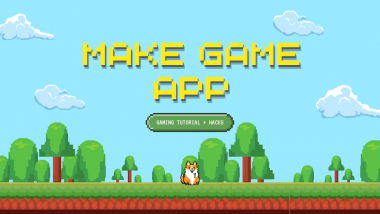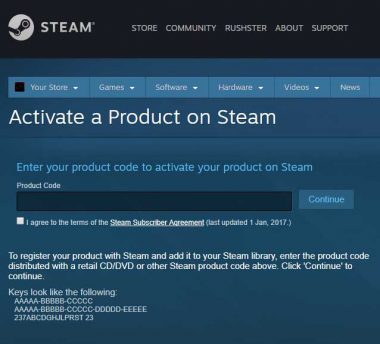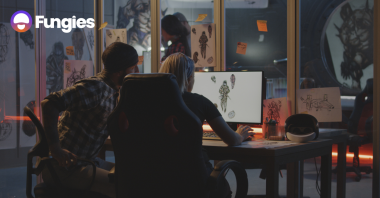In the dimly lit room of your imagination, you, the budding game developer, hold a treasure. It’s not gold, nor jewels, but an idea—an idea that could become the next gaming sensation. You’ve spent countless hours envisioning the gameplay, crafting intricate storylines, and designing characters that could rival the gaming legends. Now, it’s time to step into the spotlight and share your vision with the world. But how do you take that spark of creativity and turn it into a blazing success? How to pitch a game idea?
The Importance of a Well-Crafted Pitch
In the vast world of game development, where giants like Electronic Arts, Ubisoft, and Activision Blizzard roam, your pitch can make or break your journey. It’s the key that unlocks doors to collaboration with top developers, securing funding, and turning your concept into a fully-fledged game. But crafting that perfect pitch requires more than just words; it demands strategy, finesse, and a deep understanding of the industry.
The Purpose of the Article
This article serves as your comprehensive guide to mastering the art of pitching your game idea to top developers. From understanding the intricacies of the gaming market to creating a compelling presentation, we’ll cover every step of the process. Whether you’re a solo developer with a groundbreaking concept or part of a small indie studio looking to collaborate with industry giants, the knowledge and techniques shared here will be your invaluable companions on this exciting journey.
Understanding the Market
Recognizing Market Trends
In the ever-evolving world of gaming, staying in tune with market trends is paramount. Developers are more likely to embrace ideas that align with current industry shifts. To captivate developers, you must first understand the trends that are shaping the gaming landscape.

Gaming trends can encompass various aspects, including genres, platforms, and player preferences. For instance, the rise of mobile gaming, the resurgence of retro-style pixel art, or the increasing demand for immersive VR experiences are all noteworthy trends. Conduct thorough research and stay up-to-date with industry news and reports to recognize these shifts and identify where your game idea fits in.
Understanding market trends not only makes your pitch more relevant but also demonstrates your commitment to creating a game that aligns with the current gaming climate. Developers are more likely to invest in ideas that show potential for success in the contemporary market.
Targeting the Right Developers and Companies
Not all developers are the same, and not all companies share the same vision. Research and identification of developers and companies whose interests align with your game concept is a crucial step in the pitching process. A well-targeted pitch has a far greater chance of success.
Researching potential partners allows you to tailor your pitch to their preferences and showcase how your game idea complements their existing body of work. It’s a strategic approach that demonstrates your commitment to a mutually beneficial partnership.
Assessing Your Game’s Unique Selling Proposition
Every successful game has a unique selling proposition (USP)—that special ingredient that sets it apart from the rest of the gaming crowd. Identifying and highlighting your game’s USP is crucial for a compelling pitch. To assess your game’s USP, consider the following:
What makes your game stand out from similar titles?
How does it provide a unique player experience?
What elements of your game are likely to generate buzz and excitement in the gaming community?
Once you’ve identified your game’s USP, ensure that it becomes a central focus of your pitch. Developers are drawn to ideas that promise innovation and a fresh perspective, so showcasing your game’s unique qualities can be a game-changer in your pitch.
Crafting the Perfect Pitch
Elevator Pitch: Conciseness is Key
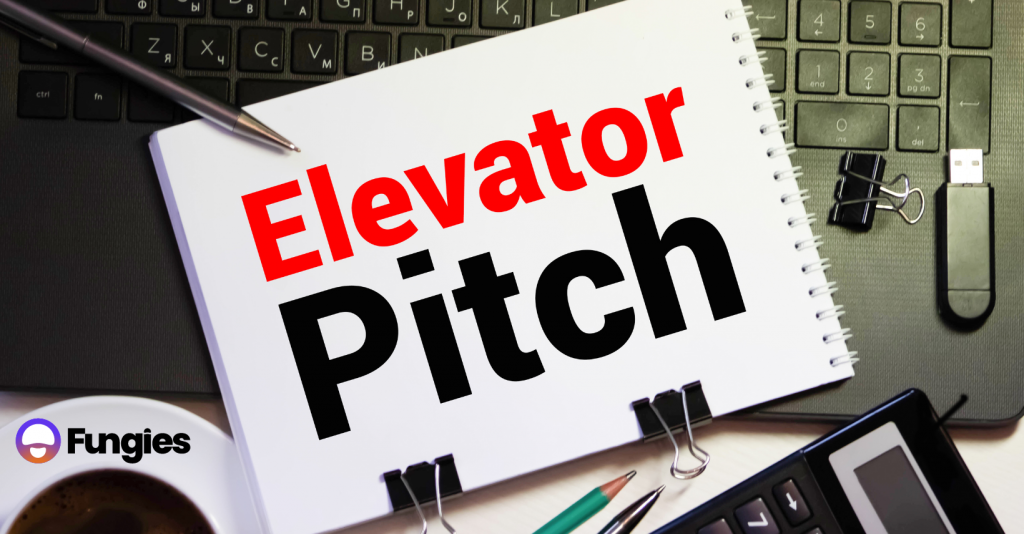
Imagine you step into an elevator with a developer you’ve been dreaming to meet. You have precisely 60 seconds to pitch your idea before the elevator doors open. Craft an elevator pitch that’s concise yet captivating, leaving them eager to hear more.
Here are some tips for creating an effective elevator pitch:
Be Concise
Keep it short and sweet. Aim for no more than two or three sentences.
Highlight the Hook
Start with a hook—a compelling aspect of your game that grabs attention.
Clarify the Genre
Mention the genre or style of the game to provide context.
Tease the Potential
Offer a glimpse of the excitement and engagement players can expect.
End with a Question
Encourage curiosity by ending with a question that invites further discussion.
Your elevator pitch should leave the developer intrigued and eager to learn more about your game. It’s the perfect opening to a deeper conversation about your idea.
Developing a Comprehensive Game Design Document
Beyond the elevator pitch, you’ll need a detailed game design document (GDD) that outlines every aspect of your game. A GDD is the blueprint that showcases your vision’s depth and potential. It’s where you provide developers with an in-depth understanding of what your game entails.
A well-crafted GDD should cover the following:
Game Concept
Describe the core idea and concept of your game.
Gameplay Mechanics
Detail how the game will be played, including controls, objectives, and player interactions.
Story and Narrative
Provide an engaging narrative that draws players into the game world.
Characters and World
Describe the characters, setting, and overall world-building.
Art Style and Aesthetics
Explain the visual style, art direction, and aesthetics of the game.
Monetization Strategy
Outline your plan for generating revenue, whether through sales, microtransactions, or other methods.
Development Timeline
Specify the timeline for key milestones, including pre-production, development, testing, and release.
Market Research
Include insights from market research, showing demand and potential audience.

Competitor Analysis
Highlight similar games in the market and explain how your game distinguishes itself.
A comprehensive GDD not only showcases your game’s potential but also demonstrates your commitment to the project. It provides developers with a clear roadmap for turning your idea into a reality.
Visual Aids: A Picture is Worth a Thousand Words
Sometimes, visuals can convey what words alone cannot. Concept art, storyboards, or a gameplay demo can breathe life into your pitch. Visual aids allow developers to envision your idea’s potential more vividly, making it easier for them to grasp the essence of your game.
Consider including the following visual elements in your pitch:
Concept Art
Showcase visual representations of key characters, environments, and scenes from your game.
Storyboards

Create storyboards or visual sequences that illustrate important moments in your game’s narrative.
Gameplay Demo
If possible, provide a playable demo or a video demonstration of your game’s mechanics and features.
UI/UX Designs
Share designs for user interfaces and user experience elements.
Visual aids not only enhance your pitch’s appeal but also help developers visualize the final product. They can be particularly effective in conveying the game’s art style, atmosphere, and overall look and feel.
Crafting a Riveting Story: Hook Them In
Storytelling is at the heart of gaming. While your GDD outlines the game’s narrative in detail, your pitch should also include a condensed yet captivating version of the story. This narrative should not only explain your game but also emotionally engage the developers.
Consider the following storytelling elements for your pitch:
The Hero’s Journey
Present your protagonist’s journey, their challenges, and the growth they experience.
Conflict and Resolution
Highlight the central conflict of the story and how it unfolds.
Emotional Connection
Evoke emotions and create a connection between the characters and the player.
Unique Selling Point
Showcase how the narrative sets your game apart from others in the same genre.
Crafting a compelling story within your pitch can leave a lasting impression on developers. It’s the narrative that players will remember long after they’ve completed the game, making it an essential aspect of your pitch.
Approaching Developers
Identifying the Decision Makers
In the labyrinth of game development companies, decision-makers hold the keys to collaboration. Identifying and reaching out to the individuals who have the authority to greenlight projects is crucial. They are your gateway to turning your idea into reality.
Start by researching the organizational structure of the developer or company you’re targeting. Understand who holds the power to make decisions regarding new projects. This may be a creative director, a producer, or a studio head. LinkedIn and industry directories can be valuable resources for identifying these key individuals.
Once you’ve identified the decision-makers, focus your efforts on making a meaningful connection with them. Your pitch is more likely to gain traction when it reaches the right hands.
Crafting a Persuasive Email or Letter
Your initial contact is critical. Whether through email or a formal letter, the way you introduce yourself and your idea can significantly impact the reception of your pitch. Craft a persuasive message that conveys your enthusiasm and professionalism.
Key elements to include in your email or letter:
Introduction
Start with a concise introduction, stating who you are and your purpose for reaching out.
Personalization
Mention why you’ve chosen to approach this specific developer or company and why your game aligns with their work.
Pitch Overview
Provide a brief overview of your game idea, highlighting its unique selling points.
Call to Action
Clearly state your intention to discuss the idea further and express your eagerness to schedule a meeting or presentation.
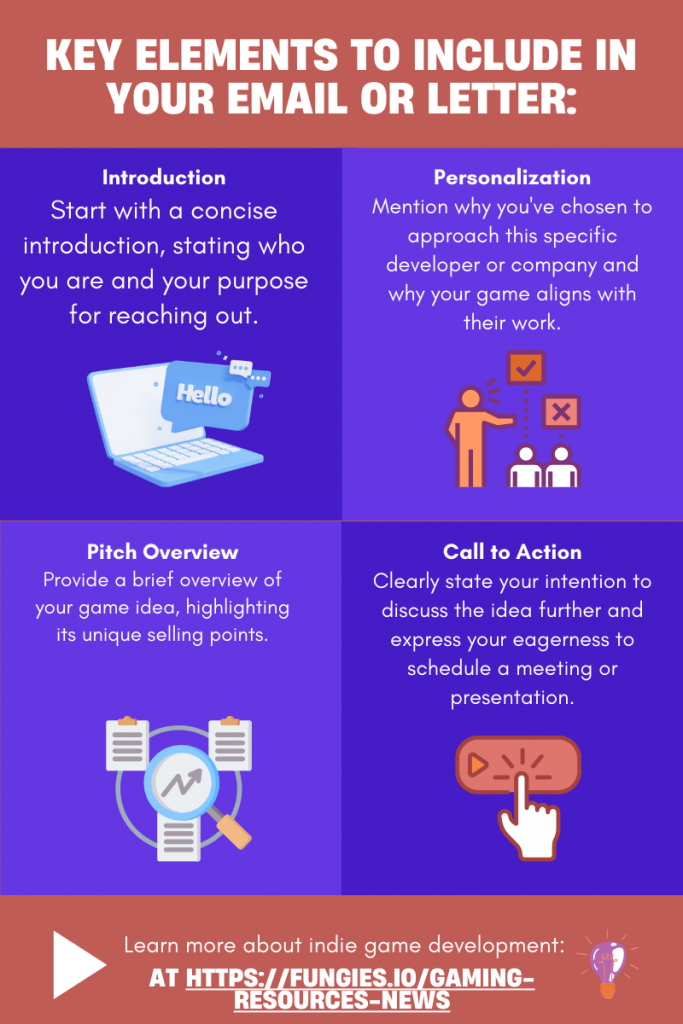
Your introductory message should be engaging, concise, and tailored to the recipient. It’s your first opportunity to spark their interest, so make it count.
The Art of Following Up
Sometimes, the first pitch doesn’t seal the deal. The art of following up, done tactfully and professionally, can demonstrate your commitment and keep your idea on their radar.
After your initial contact, allow some time for the recipient to review your pitch and respond. If you haven’t received a response within a reasonable timeframe, consider sending a polite follow-up message. In your follow-up, reiterate your enthusiasm for the potential collaboration and offer to provide any additional information they may need.
The Presentation
Confidence is Your Ally
Confidence is your secret weapon during presentations. Speak with conviction and passion. Developers want to see that you believe in your idea wholeheartedly.
As you prepare for your presentation, remember that you are the expert on your game idea. No one knows it better than you do. Embrace this knowledge and present it with confidence.
Tailoring Your Presentation to Your Audience
Different developers have different priorities. Tailoring your presentation to address the specific concerns and interests of the developer or company you’re pitching to is crucial. A personalized approach demonstrates your attentiveness and the effort you’ve invested in understanding their needs.
Consider the following when tailoring your presentation:
Portfolio Alignment
Highlight how your game complements the developer’s existing portfolio.
Monetization Strategy
Address how the game will generate revenue and contribute to their business goals.
Target Audience
Explain how your game caters to the developer’s target audience or expands their market reach.
Development Resources
Discuss your team’s capabilities and how they align with the developer’s needs.
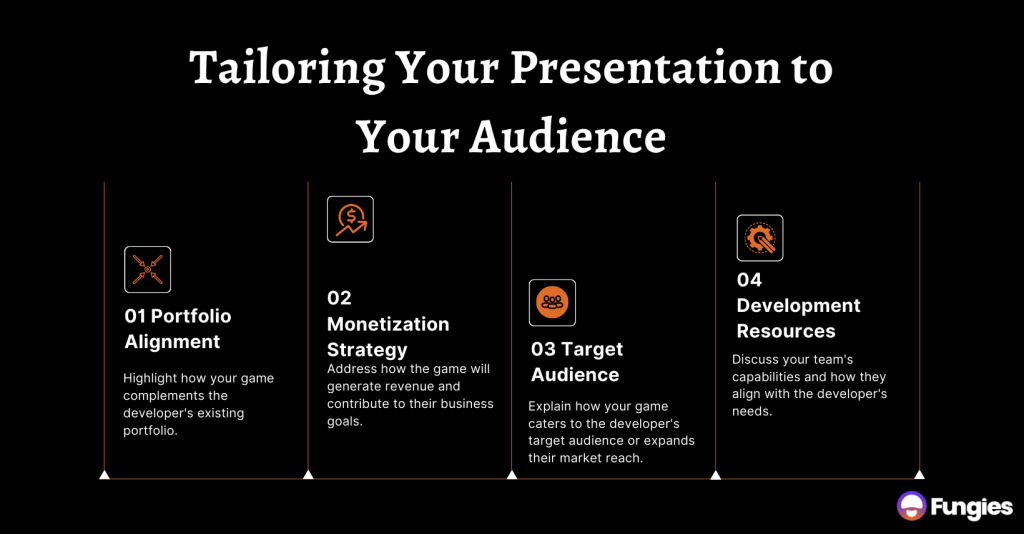
Tailoring your presentation doesn’t mean deviating from your core message; it means emphasizing the aspects that matter most to your audience. It’s about showing that your game idea isn’t just a great concept but also a strategic asset for the developer.
Addressing Concerns and Handling Objections Gracefully
Expect questions and concerns from developers during your presentation. Addressing these with grace and transparency is essential. Developers want to see that you’ve considered potential challenges and have solutions in mind.
Common concerns that developers may raise include:
Development Resources
How will the game be developed, and does your team have the necessary skills?
Market Viability
What evidence do you have that your game will succeed in the market?
Monetization Strategy
How will the game generate revenue, and is it sustainable?
Competitive Landscape
How does your game compare to similar titles, and what sets it apart?
Prepare responses to these potential concerns and objections in advance. Be honest and forthright in your answers, demonstrating that you’ve thought through these issues thoroughly. Handling objections professionally can instill confidence in your ability to navigate challenges and deliver a successful project.
Legalities and Protecting Your Idea
Non-Disclosure Agreements: Friend or Foe?
Non-disclosure agreements (NDAs) can protect your idea from being misappropriated. These legal agreements establish a confidential relationship between you and the developer, ensuring that they cannot share, use, or replicate your idea without your permission.
While NDAs can provide valuable protection, they can also be a double-edged sword. Some developers may be hesitant to sign NDAs, especially in the early stages of discussions. It’s essential to use NDAs judiciously and consider the following:
Timing
Assess whether it’s appropriate to introduce an NDA in your initial contact or if it should be discussed later in the negotiation process.
Mutual Benefit
Highlight the mutual benefits of the NDA, such as protecting the developer’s interest in the idea as a potential collaborator.
Customization
Work with legal professionals to customize the NDA to fit the specific needs and concerns of both parties.
Navigating the use of NDAs requires a balance between protecting your idea and fostering trust in your collaboration. It’s advisable to seek legal counsel to ensure your interests are safeguarded effectively.
Intellectual Property Rights: Safeguarding Your Creativity
Understanding intellectual property (IP) rights is crucial in the world of game development. Your game concept, characters, and any unique elements are your creative work, and you have the right to protect them.

Consider the following aspects of IP protection:
Copyright
Understand how copyright law applies to your game’s creative assets, including art, music, and writing.
Trademark
Explore the possibility of trademarking elements associated with your game, such as logos or distinctive names.
Patents
While less common in gaming, patents can be relevant for unique gameplay mechanics or technologies.
Contracts
Ensure that your contracts and agreements clearly define the ownership and usage rights of all parties involved.
Consulting with intellectual property attorneys or specialists can provide valuable guidance in safeguarding your creativity and negotiating fair terms with developers.
Closing Thoughts
Learning from Rejections: Every “No” is a Step Closer to a “Yes”
Rejections are part of the journey. In the competitive world of game development, every “no” is not a failure but a stepping stone toward a “yes.” Embrace rejection as an opportunity to learn, refine your pitch, and grow as a game developer.

Developers receive countless pitches, and not all can be greenlit. Your idea may not align with a particular developer’s current priorities, or it may face competition from other promising projects. The key is to persevere and continue refining your pitch and your game.
Perseverance and Patience: The Game Developer’s Companions
In the world of game development, perseverance and patience are your steadfast companions. The road to success is rarely linear, and securing collaboration with top developers may take time. However, with determination, a well-crafted pitch, and a commitment to your vision, your game idea may find its way into the hands of the giants of the industry.
Remember that every successful game, from indie gems to blockbuster titles, started as an idea in the mind of a passionate developer. Your journey as a game developer is an adventure filled with challenges, triumphs, and the potential to create experiences that resonate with players around the world. So, go forth with confidence, pitch your game idea to the giants, and let your creativity shine in the realm of game development.




